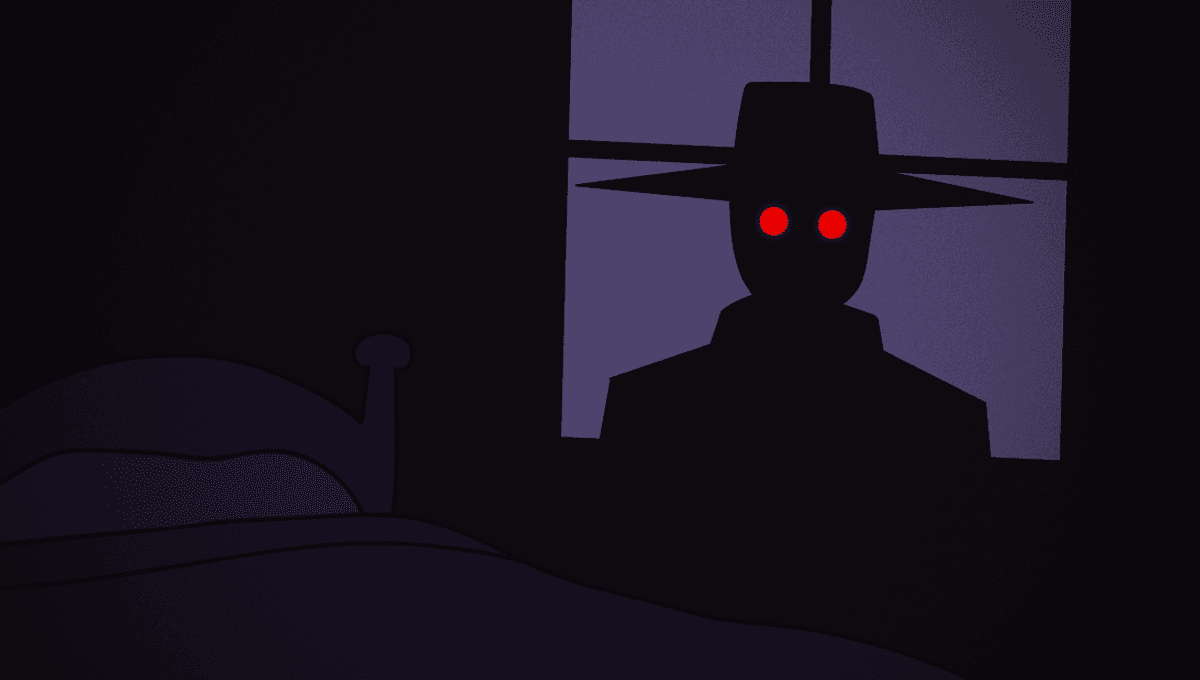
You wake suddenly in the night and find yourself facing a shadowy figure. It looms over you, the eery silhouette topped with what looks like a fedora. You feel as though your arms have been tethered to your body and you can’t move. Your eyes scan the room, it’s 3 am (there’s a reason why that happens), and you have just been visited by The Hatman.
If the above scenario sounds familiar, chances are you’ve experienced what’s known as sleep paralysis. A form of parasomnia, this haunting sleep condition is a kind of waking nightmare as many people see visual hallucinations despite being awake. Weirdly, a lot of people report the same experience of seeing a shadowy figure, and even more strangely still, this “demon” is often sporting a hat.
This fashion-forward figure has been reported by so many people that it’s earned its own nickname in sleep paralysis lore: The Hatman. It rarely moves, and sometimes evades being directly looked at, but many people report being absolutely certain that an elusive figure is lurking in the room as they struggle to regain control of their body (and some people think this may explain alien encounters).
One account of a visit from The Hatman comes from Ontario resident Mary Vincent who, in Darkness Walks: The Shadow People Among Us by Jason Offutt, said, “He just sat very still and the darkness of the room wouldn’t allow me to see his face. It seemed as if he had a hat on. I was totally terrified. I tried to move but found I couldn’t. I couldn’t even turn my head away.”
Seeing shadowy figures isn’t unusual for sleep paralysis. Even in the ancient Greek physician Galen’s day, he was trying to figure out an alternative explanation for sleep paralysis that didn’t attribute people’s experiences and hallucinations to supernatural origins. His theories mostly centered around gastric disturbances including excessive alcohol consumption, which actually may contribute to some people’s risk of experiencing sleep paralysis.
“But what’s with the hat?” I hear you ask. It’s a very good question, and one that Timothy M Brown, Jr. set out to answer in the early 2000s with The Hatman Project. The website is packed with people’s accounts of meeting The Hatman, so why might so many people experience the same hallucination? It could be that increased awareness of hallucinations through nicknames like The Hatman could, in itself, be enough to make someone see such a figure.
“In a phenomenon known as cultural priming, shared cultural narratives of sleep paralysis, such as attacks from sinister figures, can predispose individuals to experience a greater fear reaction, a more intense effort to escape paralysis, and culture-dependent hallucinations,” wrote Standford University’s Dr Cyle Johnson in his paper Sleep Paralysis: A Brief Overview of the Intersections of Neurophysiology and Culture. “The clinical significance of cultural priming is apparent in sleep paralysis, such that cultures with elaborate narratives surrounding sleep paralysis are associated with a higher number of lifetime episodes, greater distress, and longer durations of immobility.”
We see examples of cultural priming across the globe. For example, among Inuit communities, the experience has been linked to spiritual attacks from evil shamans attempting to steal an element of a person’s soul known as the tarniq. In parts of Brazil, meanwhile, the phenomenon is tied to folk tales about a prowling, long-nailed monster called the pisadeira who sits on people’s chests while they sleep. The Hatman may be another example of an idea that has spread among a certain community, influencing the experiences, or recollections, of people’s sleep paralysis.
Emeritus Professor of Psychology at Goldsmiths, and expert in the field of anomalistic psychology, Chris French wants to get the word out on sleep paralysis so that people won’t be dismissed or seen as crazy if they share their experiences. As he told IFLScience, while sleep paralysis isn’t considered to be dangerous, it can come with some seriously scary symptoms.
“For a smaller percentage of people, it can be associated with these other symptoms that can make it absolutely terrifying,” he said. “Sometimes it’s just a very strong sense of presence. You are convinced that there is some malign entity in the room kind of about to get you and do horrible things to you, but you may actually also kind of get hallucinations in any sensory modality.”
“You may hear voices or footsteps, or you may see demons or lights move around. It can be anything that your imagination can dream up. You can you can open your eyes, surprisingly. One of the few parts of your body that you can move is your eyes, so you can see you’re in your bedroom, but it does not feel like a dream.”
“It’s a kind of combination of normal waking consciousness and REM consciousness, rapid eye movement consciousness, which is the phase of sleep associated with vivid dreams. So, all that weird imagery is coming through into normal consciousness. I get sent lots of first-hand accounts, and even though these are people who know that it’s a hallucination, it’s absolutely terrifying because it feels so real while it’s happening.”
So, if you’ve seen The Hatman, try not to worry too much. He isn’t real, he can’t hurt you, and you’re not alone in having experienced this bizarre hallucination.
Source Link: Have You Seen "The Hatman"? Reports Of This Creepy Sleep Paralysis Figure Are Surprisingly Widespread